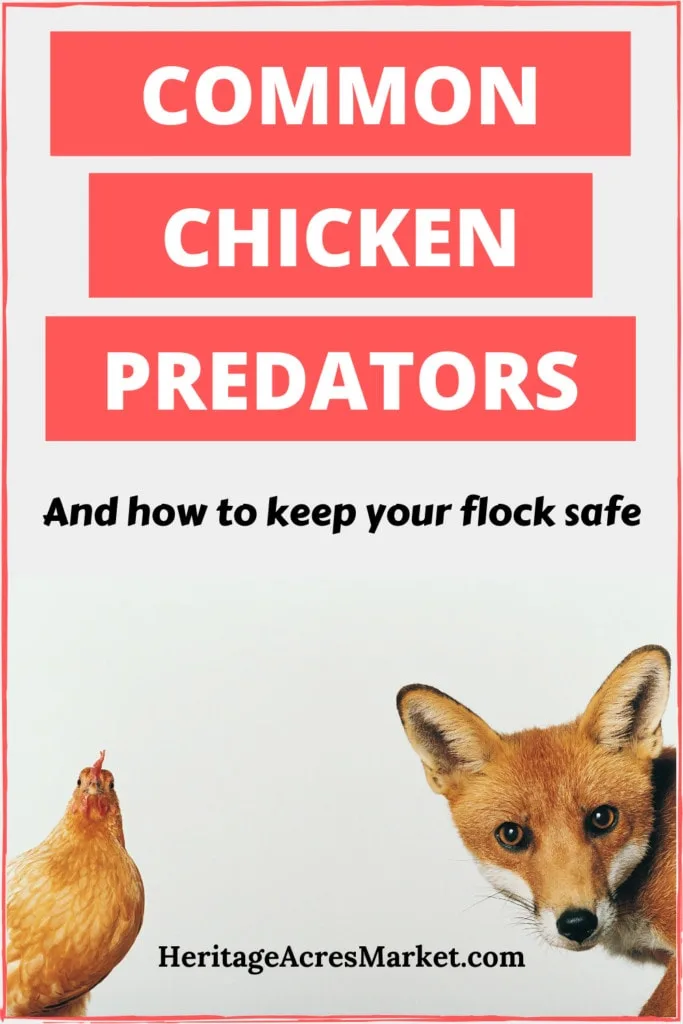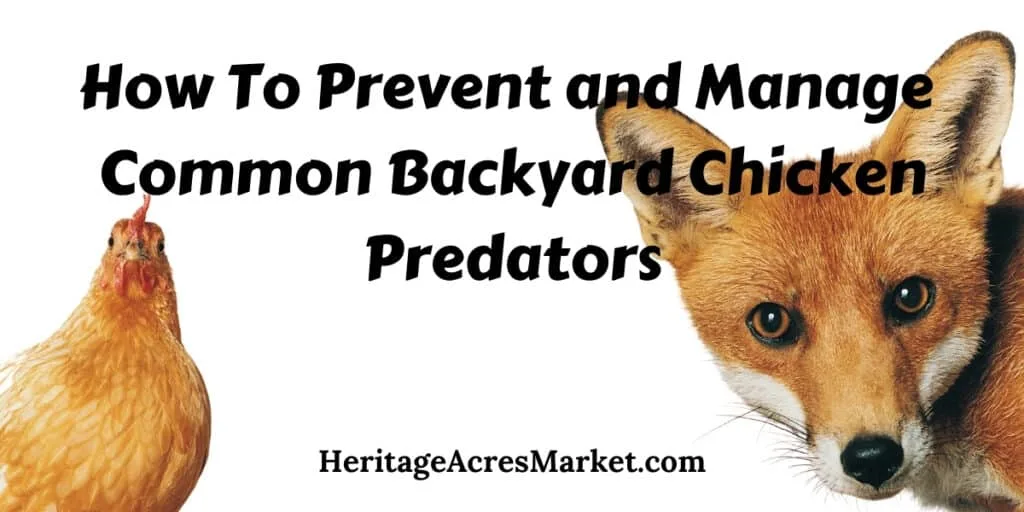
Chicken predators are a common problem for poultry keepers of all levels, from backyard to small scale operations.
According to experts like Dr. Matt Springer, Assistant Extension Professor of Wildlife Management at the University of Kentucky and the Kentucky State Wildlife Extension Specialist, adaptation is key when dealing with such issues.
That’s the entire game of farming, whether it’s livestock or poultry: adapt, adapt, adapt! Something new is definitely going to happen.
– Dr. Matt Springer
If you’re looking for more information on how to deal with chicken predators, we’ve got you covered. This post discusses poultry predators, predator management and mitigation, and the legal and social consideration regarding predator control.
You can also listen to this information in Episode 80 of the Backyard Bounty Podcast– Prevention And Management of Common Backyard Chicken Predators.
Table of Contents
Learn Your Chicken Predators
The more you can learn about what predators you have in your area, the more successful you’ll be in your efforts to keep your chickens safe.
Before building your chicken coop, try connecting with other chicken owners in your area to see what kinds of predators exist and see what has worked for them to keep chicken predators at bay.
This research will also help you avoid the hassle and costs of unnecessary protective measures down the road, as well as the heartbreaking loss of one of your chickens.
There are many ground and aerial predators that can be a threat to your chickens. We have narrowed down the most common type of chicken predators and the techniques for keeping your flock safe.
Raccoons
Raccoons can be quite challenging to deal with. If they happen to get into the chicken coop, you probably won’t have a flock left. They are clever animals, stronger than most people realize, and will problem-solve to get to a meal if they can.
Raccoons are strong enough to rip apart 8 gauge or 10 gauge chicken wire open. They can also catch and kill big, powerful birds like peacocks. Raccoons have very nimble fingers, and they’re good at using them.
When adding wire to your chicken coop, be sure to attach it to a very sturdy piece of wood, and make sure there are no loose edges that raccoons can use to gain access.
If prevention doesn’t work, you might have to trap the raccoons to remove them. Once they figure out there’s a food source, they will keep returning to that food source.
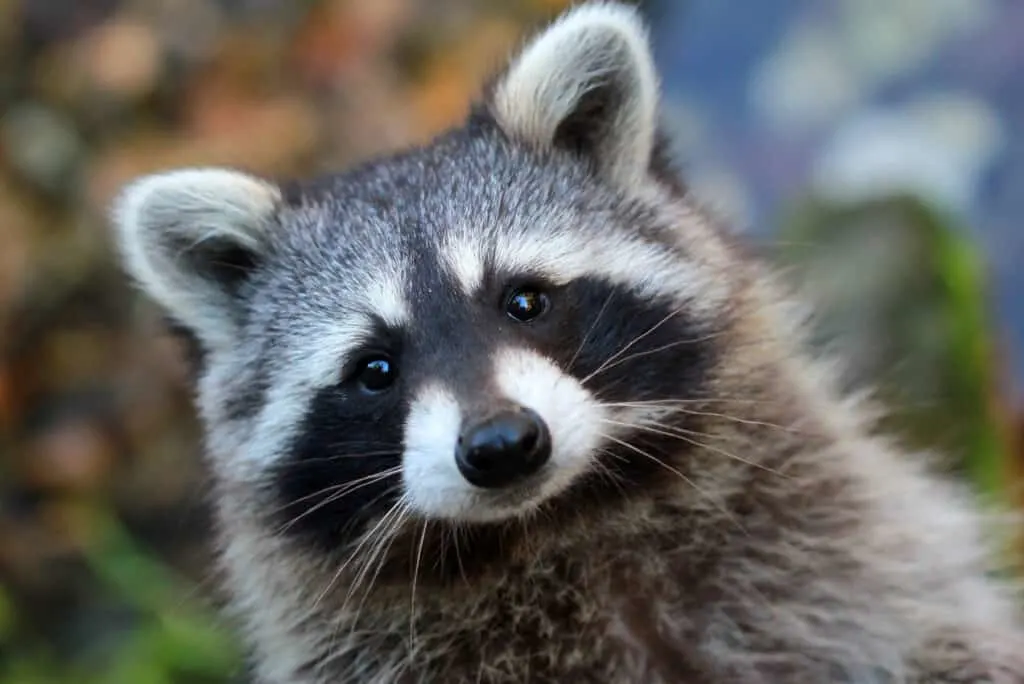
Mitigation Techniques
Raccoons can easily figure out if there are chickens around because of their strong sense of smell. But there are some ways to keep raccoons out of the chicken coop and keep your birds safe.
Secure Your Flock
Make sure you’re securing your chicken flock, especially at night. Build or modify your coop to be inaccessible from any outside predators, and close your chickens in the coop at night.
This is important to keep your flock safe from most chicken predators, including foxes, coyotes, and bobcats. You don’t want to give the predators easy access to the flock when they’re roosting.
Prevent Access To Feed
Raccoons love chicken feed, so by keeping raccoons out of the food, you’re taking the most attractive meal away from them. Raccoons are unlikely to keep frequenting the area if there’s no food reward.
So if you secure the flock at night and secure their food, raccoons are less likely to be around.
Foxes
Many people have issues with foxes. If you have free-ranging birds, it can be a challenge to keep them safe. Chickens are a highly attractive meal for animals like foxes and coyotes – predators that can also dig and get into chicken coops.
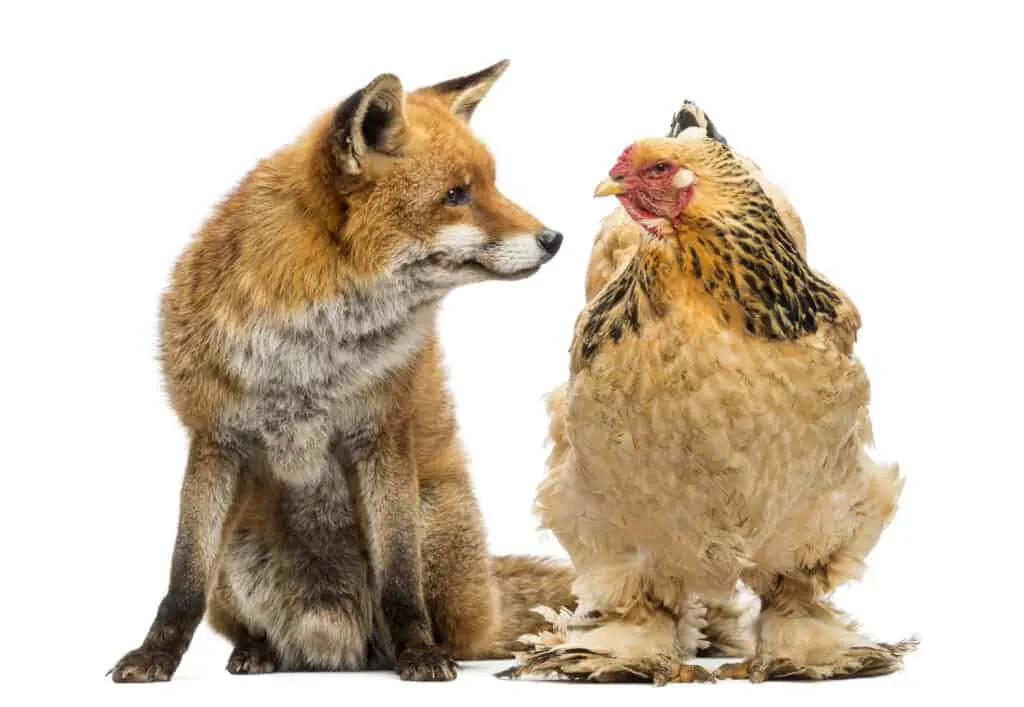
Mitigation Techniques
Foxes are a highly intelligent chicken predator, and one that can be more difficult to keep away from your flock.
Livestock Guardian Dogs
Guard dogs can be an effective strategy for keeping foxes away – but it’s a tremendous investment. Livestock guardian dogs are better suited for larger operations where there is an economic benefit for keeping a fox away. However, if you have just a small flock, it probably wouldn’t pay off to have a Livestock guardian dog.
Keep The Area Open
On a smaller scale, you can make sure that your birds are in the open so they can see a predator coming from afar. Keeping grass mowed short helps so that foxes can’t sneak up on chickens. There shouldn’t be anything that the foxes can use to hide in or use as camouflage to hunt chickens.
Add Escape Perches
Consider adding several strategically placed perches or structures where chickens can get up onto and escape from a fox.
Electric Poultry Netting
Electric perimeter fences can keep foxes and other ground predators like coyotes or badgers from getting to the chickens. These fences are also easy to move so that you can give chickens free-range access to different areas.
Add A Perimeter Skirt
For the chicken coop or pen, consider adding a perimeter fence skirt or apron. This skirt is a fence buried into the ground about six inches and then bent outwards by about six inches. When a digging animal tries to dig into the coop, they are stopped by this buried perimeter skirt. They’re not smart enough to back up a few inches and dig again.
Coyotes
Coyotes are likely the most common chicken predator.
Interestingly, evidence shows that efforts to reduce coyote populations by trapping or killing coyotes will actually do the opposite.
While you may temporarily reduce the population, there is now more food available for the remaining coyotes. When there is more food available, they will have more pups, which increases the number of coyotes in the area.
Coyotes are very territorial. If you have a pack of coyotes on your property that aren’t causing you any issues, they should be left alone. These “well-behaved” coyotes will keep other coyotes away. If you remove them, you may get new individuals and new personalities, potentially making your life harder.
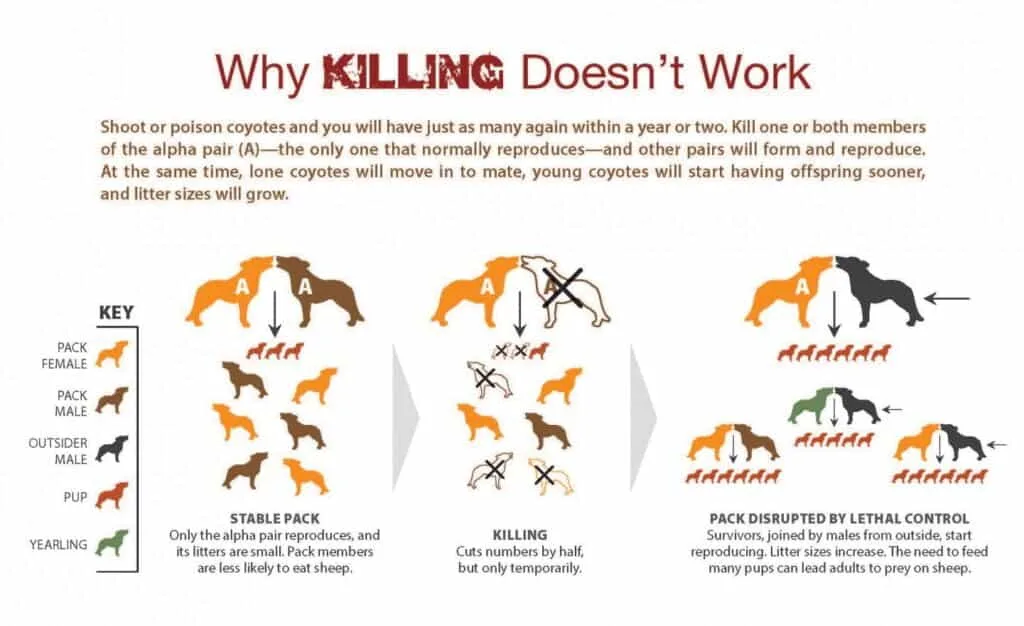
Mitigation Techniques
If you have coyotes around that do not cause a problem, don’t try to remove them from the area.
However, if you have coyotes killing your chickens, contact your local Wildlife Agency for assistance.
Hawks, Eagles, and Owls
Aerial predators are a complicated problem. Unlike raccoons or coyotes, hawks, owls, eagles, and all other birds of prey are all federally protected under the Migratory Bird Treaty Act of 1918.
Under the Migratory Bird Treaty Act, penalties include a maximum of two years imprisonment and a $250,000 fine for a felony conviction. A misdemeanor violation comes with a maximum sentence of six months in prison and a $15,000 fine. [source]
There is no lethal option for these raptors. Still, some adaptations can be made so that chickens and birds of prey can live harmoniously.
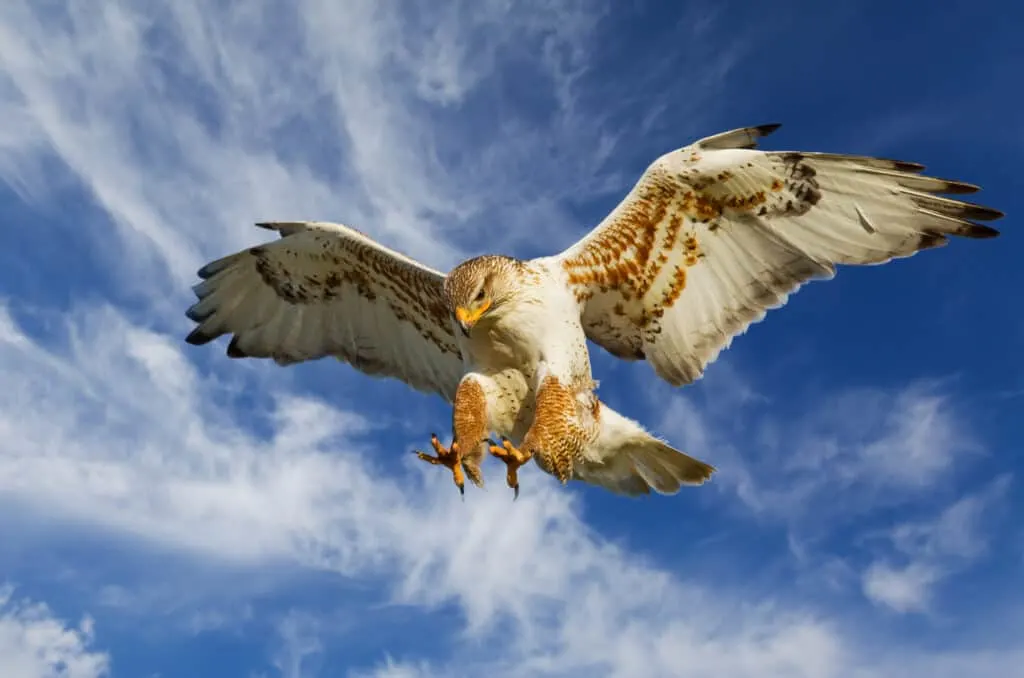
Mitigation Techniques
Contrary to belief, not every hawk is a “chicken hawk”. There are a number of bird of prey species that have no interest in eating your chickens.
Even some larger hawks like Swainson’s Hawks, which may look menacing, only eat insects or small rodents. Others stick to songbirds. Proper identification of the local raptor population will help you to know which ones are possible chicken predators.
Hawks are easily spotted when flying, so they usually hunt from a perch like a tree or a telephone pole.
Try to reduce things aerial predators can use as hunting perches. If you have old, dying trees in the area your chickens roam, cut them down if you can to remove a potential perching location.
You can also place shelters that chickens can use to hide underneath. Consider placing several in the area, so your chickens have multiple escape routes.
For owls at night, you need to have an overhead cover on your pens – whether it’s soft netting, a metal wire fence, or a solid roof.
If you opt for loose netting, keep in mind that a hawk or owl may be able to break through it or be able to pin a chicken to the ground from the outside.
Visual deterrents like shiny plates, streamers, or scarecrows do not seem to work with hawks or eagles.
There is some evidence that lasers will help keep most bird species away, including hawks and eagles. However, these automated laser systems are very expensive.
Handheld laser pointers may be effective, but they would require you to be actively watching over your flock while they free range.
Legal And Social Considerations Of Predator Control
When it comes to chicken predator prevention, it is important to try to be proactive and not reactive.
Being proactive and preventing a predator from becoming a problem in the first place is ideal. Once an animal has become a nuisance, it is very difficult to change its behavior.
Try to go through all the steps possible to avoid needing to trap or kill chicken predators. Techniques like deterrence, exclusion devices such as fencing, and trying to change your own behaviors are some steps you should take before eliminating the animal.
Unfortunately, there are situations when you can’t always fence an animal out or deter them from your flock. In these cases, except birds of prey, these nuisance animals may need to be dispatched or relocated.
Legal and Social Issues
If you have issues with nuisance wildlife, reach out to your State Wildlife Agency and find out what the predator management laws are in your area.
In some states, there may be a landowner law that allows the citizens to protect themselves or their property from any wildlife damage, giving them the right to trap or shoot animals, as long as they are not a federally protected species.

Relocation
Relocating animals is highly discouraged because of disease transmission and social hierarchies.
When relocating an animal, you don’t know if it’s carrying any diseases. It may also have ticks or other parasites that can be transmitted to other animals.
Animals have a social structure hierarchy. When you relocate an animal to a new area, it competes for resources with existing species. This limits food supplies, and there may be competition territory or for mates.
This can lead to fights amongst new and existing animals, potentially leading to injury or death.
A 2004 study of grey squirrels who were live-trapped and relocated from suburban areas to a large forest showed that a staggering 97 percent of the squirrels either soon died or disappeared from their release area.
Dispatch
If a chicken predator has become a nuisance animal, the most humane action is often to dispatch the animal. Dispatching means to kill the predator humanely.
Be sure to contact your State Wildlife Agency for guidance and to ensure you are abiding by all applicable laws.
Dealing With Chicken Predators
If you find yourself dealing with a chicken predator problem, consider contacting your Cooperative Extension Service or reach out to the State Wildlife Agency for help.
Knowing what chicken predator you are facing and species specific control measures will help keep your chickens safe.
Identification
If you see a predator near your chickens, you need to figure out what you can do to eliminate the possibility of the animal reaching your flock before it becomes a problem.
Positively identifying the animal is critical for knowing what the next steps are to protect your flock.
Change your behavior
Can you change your own behavior to solve the problem? Are you accidentally contributing to the problem?
For example, feed your chickens the amount of food they’ll eat in one day, so there’s not extra food overnight that could attract possums and raccoons.
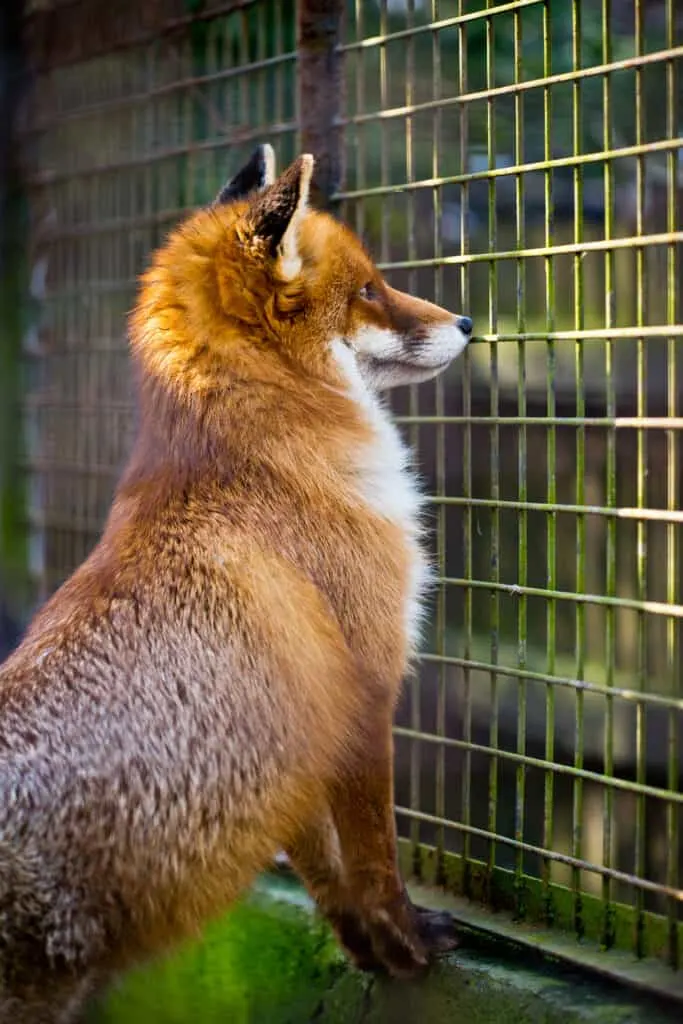
Exclusion
Can you exclude chicken predators from areas where you don’t want them to be?
Build or modify your hen house so that it is safe from predators. Add a roof and skirt to the perimeter of your pen.
If your flock free ranges, provide them escape routes like tall perches and overhead shelters.
Electrical poultry netting can keep foxes and coyotes from getting too close to your chickens.
Livestock guardian dogs can also keep chicken predators of all kinds away.
Predator Specific Control
Many of the predator deterrence and mitigation strategies for chicken predators are species-specific. The only all inclusive solution is keeping chickens permanently confined to a well built coop and run.
If you lose chickens to a predator, do your best to correctly identify it so you can take action to prevent further losses.
Contact your local Cooperative Extension Service or reach out to the State Wildlife Agency for help with these issues and guidance to solve them.
Summary
While chicken predators can lead to troublesome situations, there are several steps that you can take to prevent and manage them. It’s important to learn and know as much as you can about these measures to proactively figure out the best solutions for your specific predator issues.
Besides taking preventative measures, It’s also helpful to reach out to the authorities to identify particular chicken predators and the resources available to solve the problem.
Additional Resources
- Hawks and Owls, Human-Wildlife Conflicts
- University of Kentucky Predator Management for Small-scale Poultry Enterprises in Kentucky PDF
- University of Nebraska Identification Key to Scat
- *National Audubon Society Field Guide to North American Mammals (National Audubon Society Field Guides) 2nd Edition
- *Peterson Field Guide to Mammals of North America (Peterson Field Guides (Paperback)) Paperback – October 1, 2006
- *National Audubon Society Pocket Guide: Familiar Animal Tracks of North America
- *Bird Netting 50’x50′ Heavy Duty Nylon Netting for Bird, Poultry, Deer and Other Pests
FAQ
What animals are chicken predators?
How do you predator proof a chicken run?
Will lights keep predators away from chickens?
PIN THIS POST
